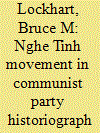| Srl | Item |
| 1 |
ID:
174136


|
|
|
|
|
| Summary/Abstract |
The abdication of Prajadhipok, King of Siam, in 1935 marked the end of the reign of the country's last absolute ruler and brought a young prince, Ananda Mahidol, to the throne in his place. Over the next decade, Ananda would rule in absentia as he grew up in Switzerland, leaving the regime considerable latitude to consolidate its authority over the monarchy and royal affairs. This article looks at three aspects of this period: the abdication as triumph of the authority of the Constitution over that of the king; the succession to the throne of a branch of the royal family that would otherwise have been bypassed; and the extended regency, which sanctioned rather than resisted the strengthening of government control over the monarchy.
|
|
|
|
|
|
|
|
|
|
|
|
|
|
|
|
| 2 |
ID:
110217


|
|
|
|
|
| Publication |
2011.
|
| Summary/Abstract |
The significance of the High Tide of 1930-31 lies not only in its impact on the evolution of the Vietnamese Revolution, but also in its status as a microcosm of policy debates and personality conflicts within the Indochinese Communist Party. This article looks at how the evolution of the Party's historiography of 1930-31 can be analysed in terms of broader political developments in Vietnam, such as struggles over ideology and the growing leadership role of Hô Chí Minh.
|
|
|
|
|
|
|
|
|
|
|
|
|
|
|
|
| 3 |
ID:
076275


|
|
|
|
|
| Publication |
2006.
|
| Summary/Abstract |
This article focuses on the 1,300-page Pavatsat Lao published in Vientiane in 2000, by far the most comprehensive national history to be written since 1975. Through the review of the book's main themes and agendas, it seeks to show how the Lao past is being constructed and reconstructed as the nation enters the twenty-first century. Of particular interest is the treatment of early Lao civilization, as well as the ways in which the past is being reconstructed to minimize ethnic difference and to produce an integrated multi-ethnic history.
|
|
|
|
|
|
|
|
|
|
|
|
|
|
|
|